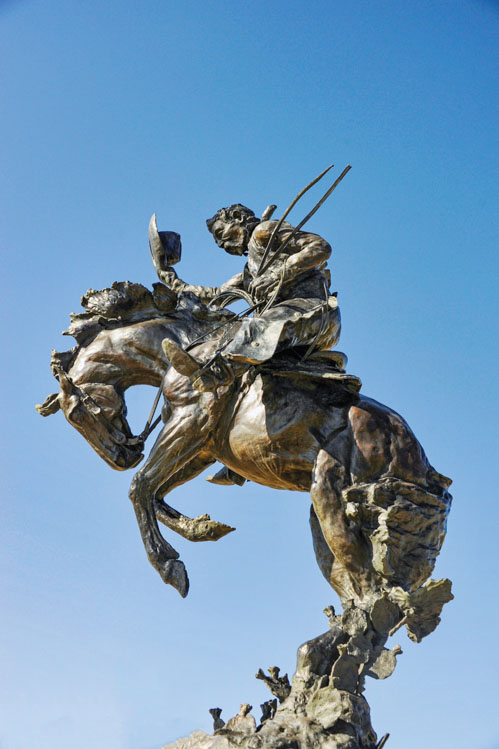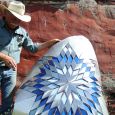The Gift of South Dakota
Subscriptions to South Dakota Magazine make great gifts!
Subscribe today — 1 year (6 issues) is just $29!
The Cowboy’s Artist
 |
| Tony Chytka fired his sculpture of saddle bronc champion Clint Johnson in his Belle Fourche foundry. |
A BLACK CAT PURRS beside a homemade kiln that would raise the eyebrow of any OSHA inspector, but Tony Chytka doesn’t seem worried. “They would probably have a fit with me, but I’m the only one out here,” he says.
“Out here” is Chytka’s 360-acre ranch, which lies in a zigzag of red dirt roads southeast of Belle Fourche along the Belle Fourche River, part of the historic Redwater Irrigation District. The peak of Bear Butte, some 20 miles away and still snowcapped on an early May morning, is just visible on the southeastern horizon. He bought the place 20 years ago. He keeps a few cows and horses and puts up some hay. Chykta also does some irrigating; piles of irrigation pipe lie near an old tin cattle shed that doubles as a foundry, where Chytka produces some of the best contemporary Western art in North America.
When we spoke, Chytka was laboring on a 3/4 life size sculpture of Spearfish native and four-time PRCA world saddle bronc riding champion Clint Johnson. When it was unveiled in August of 2019 at the Casey Tibbs Rodeo Center in Fort Pierre, it became the third and final piece added to the center’s sculpture garden, which is a tribute to South Dakota’s amazing history of exceptional saddle bronc riders.
Chytka has been on a lifelong path to becoming one of the country’s premier Western artists. He grew up on a farm west of Yankton; his surname (pronounced KIT-ka) is typical of the Bohemian families who settled that country in the late 1860s and 1870s. Growing up, he developed two passions — art and rodeo. The Chytka property also included the local saddle club arena, where South Dakota rodeo greats like Casey Tibbs performed. Chytka became enamored with rodeo at a young age. He remembers that after school at the one-room Longfellow District 11, he held on for dear life to a barrel suspended by ropes while his older brothers tugged the lines, simulating a teeth-chattering bronc ride. That led to competition in Little Britches and the high school rodeo club.
Teachers at Longfellow and the high school also encouraged his artistic endeavors. He took art classes and was introduced to sculpture during his senior year through clay modeling. While the other students were fashioning clay pots, Chytka created some 300 individual fired one-of-a-kind ceramic pieces.
 |
| After the Casey Tibbs Rodeo Center opened in 2009, Chytka donated sculptures of Casey Tibbs (left) and trick rider Mattie Goff-Newcombe. |
After graduating in 1972, Chytka enrolled at the University of South Dakota in Springfield. He took as many art classes as he could and became a member of the rodeo team, competing in bull riding and bareback bronc riding. He transferred to Black Hills State University in Spearfish in 1974, where he continued studying art and rodeoing. Chytka became a contemporary of Clint Johnson, who was on the rodeo team at South Dakota State University in Brookings. “He was a very strong rider,” Chytka recalls. “Very positive and an easy-going guy. Always had a chuckle to him.”
Drive around Belle Fourche and you’ll see evidence of Chytka’s success in Western art. Sculptures honoring brothers Marvin and Mark Garrett, two of the nation’s best bareback bronc riders, stand at the corner of Sixth and State streets. Another Chytka creation called Legacy, placed along Highway 85, was completed for the South Dakota centennial in 1989. Chytka has also memorialized Jerry Olson, a former rodeo clown and bullfighter from nearby Fruitdale, and his tribute to 1920s trick rider Mattie Goff-Newcombe can be found in Sturgis.
Chytka’s pieces are part of private collections around the world. Several are on display at the ProRodeo Hall of Fame in Colorado Springs, Colorado. So when the Casey Tibbs Rodeo Center was becoming a reality in the mid-2000s, and its directors sought art to place inside, they turned to Chytka, who donated two pieces that greet visitors as they enter: Casey Tibbs in the moments leading up to a bronc ride and Goff-Newcombe performing at the Faith Fair and Rodeo in 1928.
“He’s really a perfect fit,” says Cindy Bahe, longtime director of the center. “He’s a rodeo guy and rode broncs, so he knows exactly the stature of the cowboy and the animal. They are pretty true to life.”
The center sought Chytka’s expertise again when planning began for a sculpture garden overlooking the Missouri River. Johnny Smith, a former board member of the Casey Tibbs Foundation, was particularly proud of South Dakota’s saddle bronc riding champions and wanted to honor the very best. Plans called for three sculptures, all produced in Chytka’s Belle Fourche foundry. The first, placed in 2013, depicts Ree Heights native and five-time world saddle bronc riding champion Billy Etbauer scoring 89 atop Painted Valley at the 2009 Cheyenne Frontier Days. The second, added in 2018, is Casey Tibbs on The Old Gray Mare, honoring his performance at the Cheyenne Frontier Days in 1949, the year he won his first of six world saddle bronc riding championships. Clint Johnson, a four-time world champion, took his place in 2019.
 |
| Legacy, completed for the state centennial in 1989, was Chytka's first large-scale piece. It stands along Highway 85 in Belle Fourche. |
For Chytka, the creative process begins with a pose that perfectly encapsulates the subject and the context of the piece. “Then I’ll use other photographs to try to get a three-dimensional draw from it,” Chytka says. “It’s really hard to work off a flat surface when you’re working three dimensionally. That’s what’s unique about it. You can walk around to the other side and see the depth of it.”
Those drawings eventually become a table-size clay model on which Chytka does the brunt of the shaping and sculpting. “That’s where you do all the designing, work out all the detailing and that type of thing. There are certain guides you can use for the length of the horse’s head, the legs. A lot of it is just the view. I like to just stand back and see it all together.”
Over the next four to six months, the project goes through various stages. A rubber layer is applied on the outside of the clay, and then plaster of Paris on top of that. The process yields a wax version of the sculpture, and a ceramic shell is built around it. When the wax is melted, the shell is ready to receive molten bronze from Chytka’s homemade kiln.
Chytka brought his pieces to other foundries until 1984, when he learned the process himself at a foundry in Bozeman, Montana. “The casting process has always intrigued me,” he says. “When you use commercial foundries, pretty soon all the work from that foundry starts to look the same. There’s just as much art in the foundry process as the beginning sculpture.”
His kiln, fueled by propane and powered by a Kirby vacuum motor, heats the bronze to 2,200 degrees. It’s a two man pour, he says, meaning a man at each end of an 8-foot-long metal tong holds the piece as it’s dipped into the furnace (the 10-foot tong was too hard to handle, he explains). “After it cools you can hit the bottom of the shell with a hammer and you aren’t going to hurt it,” he says. “The permanence of it is something I always liked.”
Chytka sculpted Johnson atop Kicking Bear, the horse he rode to win his fourth championship in 1989 (his previous titles came in 1980, 1987 and 1988). Visitors who attended the unveiling surely appreciated its artistic merits, but when old cowboys — and even Chytka himself — glance into the horse’s eyes or see the way Johnson sits in the saddle, they might be transported to their old rodeo days. There will be features that only those who’ve landed on their backside in the arena will notice.
“There are little things. Positioning, the equipment, the action and that kind of thing,” Chykta says. “I’m not hung up too much on detail, just as long as it flows. But when somebody who does know rodeo says, ‘Hey, you did a good job on that,’ then that means just that much more, coming from people who have been there.”
Editor’s Note: This story is revised from the July/August 2019 issue of South Dakota Magazine. To order a copy or to subscribe, call (800) 456-5117.










Comments
I wish Tony had an online presence, but I guess he doesn't really need one. Oh, and he's a fine Western Swing dancer, too!